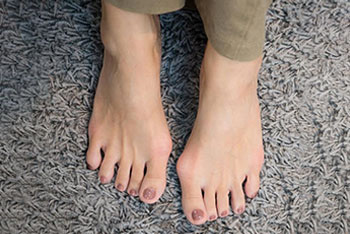Connect With Us
Bunions

A bunion is a bony, painful swelling that is often formed on the first joint of the big toe. Bunions can be extremely painful due to the weight of all your body resting on it each time you take a step. Everyday activities, such as walking and wearing shoes, can cause you extreme discomfort if you have a bunion.
Reasons that a person may develop a bunion can vary. Some patients may form bunions due to genetic factors, complications with arthritis, or a weak foot structure. General aging can also play a role in the formation of a bunion.
If you have a bunion, you may notice a bony bump on your big toe, experience swelling and redness, and the area may feel tender to the touch. To help alleviate the pain that often comes with having a bunion, it’s suggested to maintain a healthy weight to help lessen the pressure on your toe, practice both heating and icing the affected area, wear wide-fitting shoes wear to leave plenty of space for your toes and to minimize rubbing, and look into shoe inserts that can help position your foot correctly.
Because bunions can result in other painful foot problems, such as hammertoes and bursitis, we recommend that you meet with a podiatrist for a professional diagnosis and for information regarding all your treatment options.
Mini Bunion Surgery

Bunions are an unsightly and painful foot deformity where the big toe joint gets misaligned, creating a bony protrusion on the inside of the foot and causing the big toe to angle towards the rest of the toes rather than pointing straight ahead.
Since bunions are progressive, they will get more and more severe if they are left untreated. Many people may put off getting their bunion corrected because they are afraid of traditional, invasive bunion surgery, and its associated lengthy recovery times.
The MINIBunion® 3D Procedure
Crossroads Extremity Systems has created a minimally invasive procedure that corrects bunions without cutting into the toe joint (like traditional bunion surgery). It also eliminates the need for patients to wear a cast during recovery.
MINIBunion® is a more effective procedure than traditional bunion surgery because the affected bones are realigned and rotated to completely and permanently correct this three-dimensional foot deformity.
How MINIBunion® 3D Works
Your podiatric surgeon will make a mere 15mm incision, which will become virtually invisible when it heals and fades. This incision is roughly 2-4 times smaller than incisions made during traditional procedures, and is on the inside of the foot which is far less noticeable than the top of the foot-where incisions for traditional bunion surgeries are made.
Through the incision, the podiatrist will rotate and realign the bones on three dimensions. Then, a MINIBunion® 3D micro-implant will be inserted to stabilize the toe, and the tiny incision is stitched closed.
What is Recovery Like with MINIBunion® 3D Correction?
Your individual situation and your podiatrist’s recommendations will factor into your recovery time. Most patients will be able to walk immediately in a postoperative shoe following the procedure. This allows for a “walking recovery,” in contrast with traditional bunion surgery that requires patients to wear a bulky boot or cast and walk on crutches for up to ten weeks.
Talk to your podiatrist to see if your bunion can be corrected with the MINIBunion® 3D minimally invasive bunion system.
